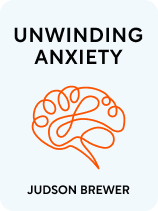

This article is an excerpt from the Shortform book guide to "Unwinding Anxiety" by Judson Brewer. Shortform has the world's best summaries and analyses of books you should be reading.
Like this article? Sign up for a free trial here.
How can you use mindful breathing for anxiety? How does mindful breathing stimulate curiosity?
In Unwinding Anxiety, Dr. Judson Brewer suggests practicing mindful meditation to defeat anxiety. One of the techniques he suggests is mindful breathing.
Continue reading for better insight on using mindful breathing for anxiety.
Mindfulness 101: Watching Your Breath
One basic mindfulness tool—and the core of many meditation practices—is mindful breathing for anxiety. Brewer recommends that when you notice yourself getting anxious—or are about to do some other behavior you’d rather change—you should pause and become aware of your breathing. Pay attention to the physical sensations of breathing (such as its length, depth, and so on), and focus on the part of your body where you most feel the breath.
Brewer argues that watching the breath breaks the anxiety habit loop and automatically replaces it with mindful curiosity. In other words, if you watch your breath whenever you start to feel anxious, then instead of feeding the anxiety by engaging with it—through worrying, coping behaviors, active avoidance, and so on—you instead relate to your anxiety as a neutral observer. Doing so disarms the anxiety and starves the habit cycle that gives rise to it in the first place.
(Shortform note: In general, when watching the breath, you shouldn’t try to breathe in any special way. The goal isn’t to change or control the breath, but simply to observe it. In fact, when practicing mindfulness, one of your goals is to remain neutral to whatever you observe. For example, in Mindfulness in Plain English, Henepola Gunaratana describes mindfulness as the act of standing back and watching whatever’s going on in your body and mind. He explains that you should practice mindfulness without expecting any particular result, without straining or rushing, and without judging your thoughts or feelings.)
That said, watching the breath doesn’t automatically make anxious thoughts and feelings go away—and that’s not the goal. In fact, once you’ve used your awareness of the breath to adopt a mindful attitude, Brewer suggests that you pay attention to where in your body you most feel the anxiety. He says you can imagine breathing into that area to focus your attention there, and you can even imagine breathing out some of the unpleasant sensations.
(Shortform note: As with the breath itself, you shouldn’t try to change or control your anxious thoughts or feelings. The goal of this exercise is to be curious about those thoughts and feelings and to observe them as closely as you can. As noted above, trying to control mindfulness to produce a specific result only undermines the process—and doing so might also exacerbate anxiety. In Radical Acceptance, psychologist Tara Brach argues that we typically resist painful or unpleasant feelings like anxiety, which only creates more problems and pain. The solution, she says, is to see things as they are (through mindfulness) and to accept them as they are (rather than fighting against or trying to avoid or change unpleasant experiences).)
Cultivating Curiosity
One of the benefits of observing the breath is that doing so encourages curiosity. Brewer considers this an ideal antidote to anxiety. He also offers several additional practices that are specifically designed to help you respond with curiosity even in difficult circumstances.
For example, Brewer recommends that when you’re stressed, anxious, or otherwise upset and you feel closed down, you say “hmm” out loud to yourself—just as you would if you encountered something interesting or surprising. He argues that saying “hmm” triggers you to become curious about whatever’s going on.
Similarly, he says that deliberately widening your eyes can trigger a curious (rather than fearful or angry) response. He points to research suggesting that we open our eyes wide when we’re trying to take in information and narrow them when trying to block out sensory input (as when something disgusts us) or focus on action (as when we’re fighting or fleeing).
(Shortform note: Many contemporary therapists recommend similar tricks to calm the body and promote desired emotional states. For example, some experts suggest that adopting a serene half-smiling expression and turning your open hands palm-up can reduce anger and frustration and increase feelings of peace and acceptance. Similarly, evidence shows that breathing such that your out-breath is longer than your in-breath triggers your body to enter a state of calm—which can help counteract the fight-or-flight instinct that drives anxiety in the first place.)

———End of Preview———
Like what you just read? Read the rest of the world's best book summary and analysis of Judson Brewer's "Unwinding Anxiety" at Shortform.
Here's what you'll find in our full Unwinding Anxiety summary:
- How to recognize and counteract anxiety with mindfulness
- Why anxiety becomes is toxic if left untreated
- A three-step method for treating anxiety






